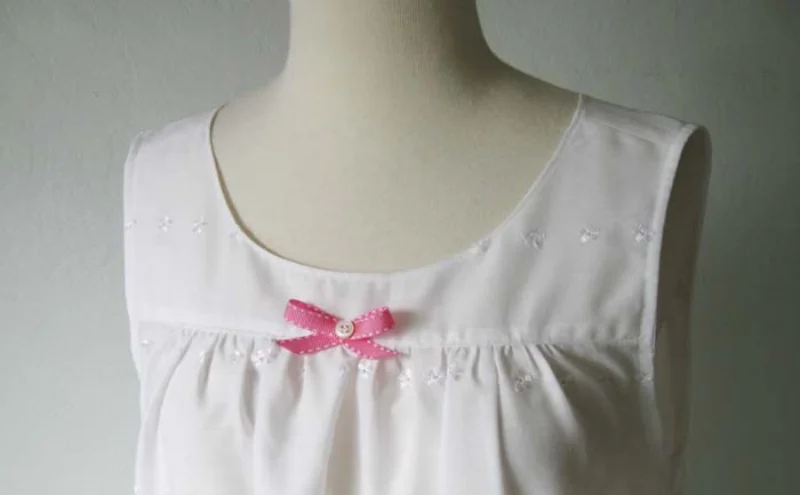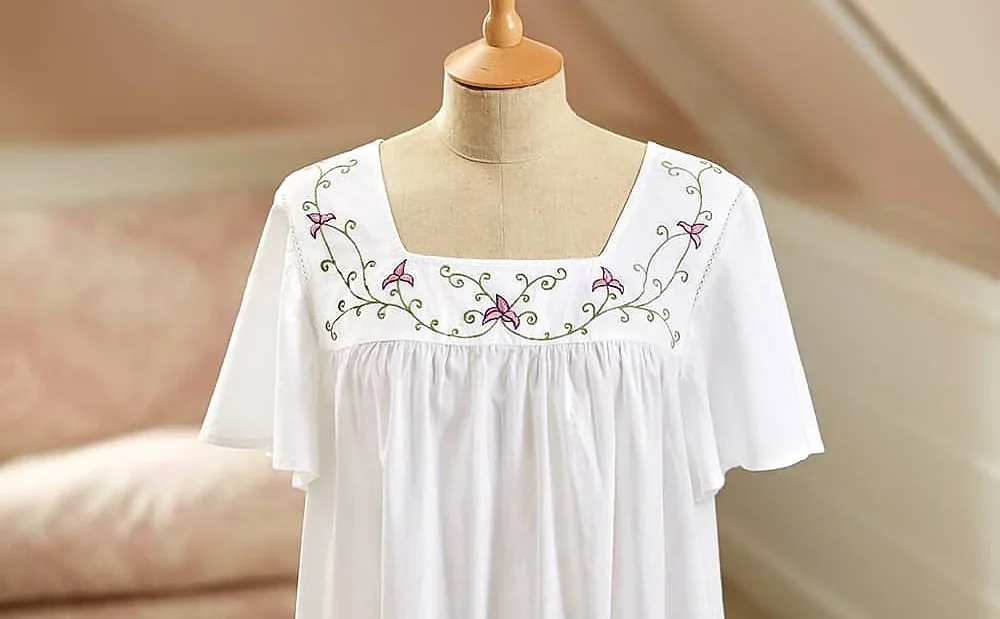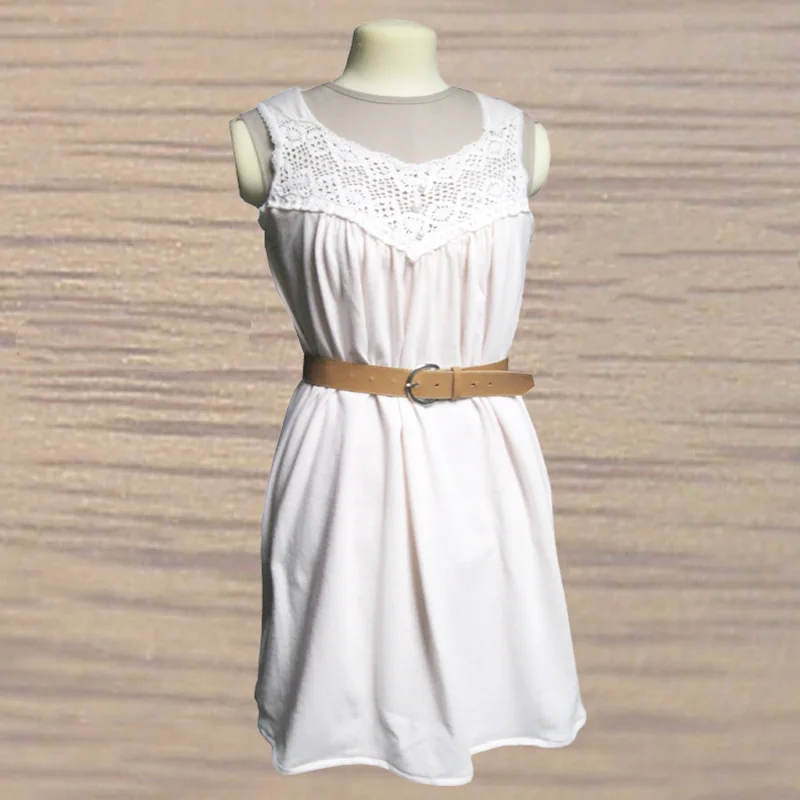Ever wondered how to turn a nightgown into a dress without any stress? You’re not alone—about 21% of Americans upcycle clothing each year, so you’re in great company. Upcycling gives you a chance to show off your creativity while helping the environment in big ways:
You cut down on textile waste and save resources like water and energy.
You extend the life of your favorite fabrics, especially when you start with high-quality Friendtex nightgowns.
Grab your materials and get ready to make something stylish and sustainable!
Key Takeaways
Choose a high-quality nightgown made from soft, durable fabrics like cotton or silk for easier sewing and a polished dress.
Gather basic sewing tools such as sharp scissors, pins, thread, and a sewing machine or needle and thread to start your project.
Prepare your nightgown by washing, ironing, and measuring carefully to ensure a good fit and smooth sewing process.
Use simple sewing techniques like adding darts, adjusting length, and finishing edges neatly to transform your nightgown into a stylish dress.
Personalize your dress with embellishments like lace, buttons, or embroidery to make it unique and reflect your style.

Materials & Tools
Basic Supplies
Ready to get started? You don’t need a fancy sewing room or expensive gadgets. You just need a few basic tools to turn your nightgown into a dress. Here’s what you should gather:
Sharp fabric scissors
Seam ripper
Measuring tape
Pins or clips
Sewing machine (or needle and thread for hand sewing)
Iron and ironing board
Chalk or washable fabric marker
Matching thread
You’ll find that working with high-quality nightgowns makes the process easier. Friendtex nightgowns—whether you choose cotton, silk, summer, plus size, or Christmas styles—offer sturdy seams and premium fabrics.
These features help you achieve a polished look with less effort. If you want to explore other brands, check out this quick comparison:
Brand | Sustainability & Upcycling Practices | Product Highlights & Suitability for Upcycling |
|---|---|---|
Friendtex | Certified sustainable, offers eco-friendly fabrics and custom options | Wide range of styles and sizes, ideal for creative projects |
NK IMODE | Uses rescued stock materials, responsibly produced silk | Timeless silk chemises and gowns, elegant and sustainable |
Anekdot | Surplus luxury fabrics, upcycled materials | Handcrafted pieces, perfect for upcycling |
Araks | Organic cotton, upcycled cotton, zero-waste approach | Colorful, sustainable lingerie, great for upcycling |
Bum-Cake Vintage | Vintage pieces from 1950s-1990s, inherently suitable for upcycling | Unique vintage lingerie, ideal for creative transformations |
Torlowei | Responsible sourcing, natural fibers, and repair services | Durable luxury lingerie, supports sustainable use |
Tip: Friendtex nightgowns stand out for their breathable cotton, elegant silk, and inclusive sizing. You’ll find them easy to work with, whether you’re a beginner or a seasoned upcycler.
Optional Embellishments
Want to add a personal touch? You can jazz up your new dress with a few extras. Here are some ideas:
Decorative buttons
Lace trim or ribbon
Iron-on patches
Fabric paint or embroidery floss
Belts or sashes
Appliqués
Beads or sequins
You don’t have to use every embellishment. Pick what matches your style and the fabric of your nightgown. Cotton and linen work well with embroidery and patches. Silk looks stunning with lace or beads. If you’re working with a Christmas or plus-size nightgown, try festive trims or bold accessories.
Note: Before you start sewing, lay out your supplies and embellishments. This helps you visualize your design and keeps your workspace organized.
How to Turn a Nightgown Into a Dress: Preparation
Choose the Right Nightgown

Picking the perfect nightgown is the first step in how to turn a nightgown into a dress. You want a piece that feels soft, looks great, and is easy to work with. Friendtex offers a wide range of options, including summer, silk, cotton, plus-size, and even festive Christmas nightgowns. Each style brings something unique to your project.
Look for nightgowns made from high-quality fabrics like cotton batiste, pima cotton, or natural silk. These materials feel comfortable and sew easily. Cotton and modal nightgowns from Friendtex are especially good for beginners because they hold their shape and don’t slip around as much as silk.
If you want to stay eco-friendly, choose nightgowns made from organic or recycled fabrics. These options support sustainable fashion and help you create a dress that’s both stylish and responsible.
Here’s a quick checklist to help you choose:
Pick soft, premium fabrics that feel good on your skin.
Choose organic or recycled materials for a greener project.
Look for durable fabrics that will last after you upcycle them.
Check for ethical manufacturing and fair-trade practices.
Avoid nightgowns with too many embellishments if you’re new to sewing.
Tip: Friendtex nightgowns come in many sizes and styles, so you can find one that matches your vision and fits your body perfectly.
Prep and Measure
Once you’ve picked your nightgown, it’s time to get it ready for transformation. Preparation is key to turning a nightgown into a dress that fits well and looks polished.
Start by washing and drying your nightgown. This step prevents any shrinking after you sew. Next, iron the fabric to remove wrinkles. Smooth fabric makes cutting and sewing much easier.
Always check the care label, especially if you’re working with delicate fabrics like silk or embellished pieces. Some materials need gentle hand washing or even professional cleaning to keep them looking their best.
Now, lay your nightgown flat on a clean surface. Use pins or pattern weights to keep it in place. If you plan to make big changes, like adjusting the length or adding sleeves, grab a well-fitting dress or a sloper (a basic pattern that matches your body shape).
Compare your nightgown to this pattern. Look at the bodice, skirt, and sleeves. Notice any differences in length, width, or shape.
Here’s a simple step-by-step guide to measuring and prepping:
Wash and dry your nightgown to prevent shrinkage.
Iron the fabric for a smooth surface.
Lay the nightgown flat and secure it with pins or weights.
Use a measuring tape to check bust, waist, hips, and length.
Compare these measurements to a dress or sloper that fits you well.
Mark any changes you want to make with chalk or a washable marker.
Cut carefully along your markings, following the grain of the fabric.
If you’re working with delicate fabrics, handle them gently. Use a mesh laundry bag for washing and avoid high heat when ironing. Store delicate pieces on padded hangers or in breathable bags to keep them in top shape. For stains, blot gently with cold water and avoid rubbing.
Note: Taking your time with prep and measuring helps you avoid mistakes and makes the sewing process much smoother.
With the right nightgown and careful preparation, you’re well on your way to creating a dress that’s both comfortable and unique. The next steps will help you bring your vision to life!
Design & Adjustments

Plan Your Style
Now comes the fun part—imagining what your new dress will look like! When you think about how to turn a nightgown into a dress, start by picturing the style you want. Do you love a relaxed, flowy look? Maybe you want something with a bit more shape or a playful ruffle.
Upcycled nightgowns often become comfortable, loose-fitting dresses with features like ruffle sleeves, lettuce-edge hems, or even a rolled hem for a soft, wavy finish. These details add personality and charm without making things complicated.
Take a look at your nightgown’s original features. Friendtex nightgowns, for example, offer so much inspiration:
Premium, breathable fabrics like linen and cotton keep you cool and comfortable.
Customization options let you play with fit, color, and design.
Styles range from classic and vintage to modern and plus-size, so you can match your dress to your mood or the season.
Flowing cuts, lace trims, and relaxed fits give you a base for both casual and elegant looks.
Eco-friendly materials mean your new dress is as sustainable as it is stylish.
Tip: Lay your nightgown flat and sketch a few ideas. Try adding ruffles from leftover fabric, or use the waistband as a cuff for the sleeves. Let the fabric and original design guide your creativity!
Simple Sewing Techniques
You don’t need to be a pro to transform your nightgown. Simple sewing techniques can make a big difference in how your dress turns out. Here are a few easy methods you can try:
Add darts: Darts help shape the bodice for a more fitted look. Mark where you want the darts, pin them, and sew along the lines.
Shorten or reshape: If your nightgown is too long, trim the hem to your desired length. Use a rolled hem or lettuce edge for a playful finish.
Create a yoke: Trace the neckline and shoulders from a dress pattern or a favorite top. Cut out yoke pieces and attach them to the main body for a polished look.
Gather the skirt: For a flowy silhouette, gather the skirt fabric before attaching it to the bodice or yoke. This adds volume and movement.
Finish edges neatly: Use bias binding or French seams for armholes and side seams. These techniques keep your dress looking clean inside and out.
Note: Always test your changes on a scrap piece of fabric or sew a quick muslin first. This helps you avoid surprises and gives you confidence before you cut into your nightgown.
Alter Length & Fit
Getting the right length and fit is key when you learn how to turn a nightgown into a dress. Start by deciding where you want the hem to fall—knee-length, midi, or even above the ankle. Use a measuring tape to mark the new length, then cut carefully along the line.
Here’s a simple step-by-step guide to adjusting length and fit:
Trace the neckline and shoulders using a favorite dress or a pattern.
Use a French curve to shape the neckline for comfort.
Cut out front and back yoke pieces. Add facings or bias binding for a smooth finish.
Measure and cut the skirt to your desired length and width. Add extra width if you want gathers.
Attach the skirt to the yoke, leaving space for armholes.
Trim and shape the armholes so they feel comfortable—sometimes a little larger than a typical dress armhole.
Sew the yoke facings and side seams. French seams work well for a neat, durable finish.
Finish the armhole edges with bias binding. Hem the skirt edge, and add ruffles or lace if you like.
Try on your dress for a final fitting. Make any small tweaks before you finish the seams.
Pro Tip: Mark your fabric pieces clearly and batch your sewing steps. This keeps you organized and helps your project move smoothly.
You can always add embellishments like bows or decorative buttons at the end. If you’re unsure about the fit, sew a quick test version with inexpensive fabric first. This way, you can make adjustments before working on your final piece.
With these simple adjustments, you’ll see just how easy it is to master how to turn a nightgown into a dress that fits your style and body perfectly. Let your creativity shine and enjoy the process!
Finishing Touches
Add Details
You’ve shaped your dress, now it’s time to make it truly yours. Personalizing your upcycled dress can be simple or bold—just follow your style. Try adding lace trims to the neckline or hem for a sweet, delicate look. Swap out plain buttons for colorful ones shaped like flowers or shells.
Sew on fun appliqués, such as stars or hearts, to cover small stains or add character. You can also use ribbons instead of drawstrings for a pop of color. If you want more texture, attach pom-pom or tassel trims along the edges.
Hand embroidery works wonders too—stitch initials or tiny motifs on cuffs or pockets for a charming touch.
Tip: Patchwork with fabric scraps or visible mending turns repairs into design features. Don’t be afraid to embrace imperfections—they add personality!
Final Fitting
A great fit makes your dress comfortable and flattering. Start by adjusting the bodice so it feels snug but not tight. Check the straps—make sure they don’t droop or dig in. If your dress has a zipper or closure, test it for smoothness and comfort.
Hem the bottom evenly, using a ruler or chalk to mark the length. Try on your dress with the undergarments you plan to wear. This helps you spot any tweaks you need. For delicate fabrics like silk, gentle handling is key. If you’re unsure about tricky adjustments, a tailor can help you get a polished finish.
Note: Schedule a final fitting close to your special event. Last-minute tweaks can make all the difference!
Styling Tips
Now you get to show off your new dress! Friendtex nightgowns come in many fabrics, so style your dress to match the occasion. Cotton and bamboo dresses feel light and breezy—perfect for summer outings. Pair them with sandals and a woven belt.
Silk dresses look elegant for evening events; add a satin sash and delicate jewelry. For holiday or Christmas styles, try cozy trims or festive accessories like a velvet ribbon or sparkly brooch. Plus-size designs shine with relaxed cuts and bold prints—add a statement necklace or a colorful scarf.
Fabric Type | Styling Ideas | Occasion |
|---|---|---|
Cotton/Bamboo | Woven belt, sandals, sun hat | Summer, casual |
Silk/Satin | Satin sash, pearls, clutch bag | Evening, formal |
Flannel | Cozy scarf, boots, knit cardigan | Winter, holiday |
Plus Size | Bold necklace, colorful scarf | Everyday, festive |
Remember: Your upcycled dress is unique. Wear it with confidence and let your creativity shine!
Troubleshooting
Common Issues
Even with careful planning, you might run into a few bumps while turning your nightgown into a dress. Don’t worry—these problems are common and easy to fix! Here are some issues you might see:
Uneven hems: Sometimes the bottom edge looks wavy or crooked after cutting.
Loose seams: Seams may come apart if the stitches are too wide or the thread is weak.
Fit problems: The dress might feel too tight in some spots or too loose in others.
Fraying edges: Raw fabric edges can start to unravel, especially after washing.
Puckered fabric: The fabric may bunch up if the tension on your sewing machine is off.
Tip: Take a deep breath and remember—every upcycler faces these challenges. You’re learning new skills, and each mistake helps you get better!
Quick Fixes
You can solve most of these issues with a few simple tricks. Here’s how to get your upcycled dress looking its best:
Trim uneven hems with sharp scissors. Use a ruler or chalk to mark a straight line before you cut.
Reseam any loose areas with a tighter stitch. Double-stitch high-stress spots like the waist or underarms.
Adjust the fit by adding darts or taking in the side seams. If it’s too tight, try adding a fabric panel or side slit.
Finish raw edges with bias tape, zigzag stitches, or a serger to stop fraying.
If fabric puckers, check your sewing machine’s tension and use a pressing cloth to iron seams flat.
Friendtex fabrics make troubleshooting easier because they’re soft, high-quality, and durable. Here’s why your upcycled dress will last:
Soft cotton blends and stretchy fabrics hold up well during sewing and wearing.
Thicker materials keep their shape, so your dress looks great wash after wash.
Proper finishing, like hemming and ironing, helps maintain the dress’s form.
You can also make your project more sustainable by:
Use leftover fabric scraps for patches or embellishments.
Wash your dress gently in cold water and air-dry to preserve fabric quality.
Designing with modular pieces so you can reuse or update your dress later.
Remember: Every upcycled dress is unique. By choosing quality materials and caring for your creation, you help the planet and enjoy a one-of-a-kind style that lasts. Keep experimenting and have fun with your sewing journey!
Conclusion
You just learned how to turn a nightgown into a dress with simple steps. Anyone can do it, even if you’re new to sewing. Try different Friendtex nightgown styles for a look that’s all your own. Many people face challenges like picking a design, resizing, or working with delicate fabrics:
Deciding on a style or pattern
Making sure the fabric holds up
Figuring out how to resize or alter parts
Share your finished dress or ask questions below. Your creativity might inspire someone else!
FAQ
How do I know if my nightgown will work as a dress?
Look for a nightgown with sturdy fabric and a style you love. If it fits your shoulders and bust, you can usually adjust the rest. Cotton, silk, and modal nightgowns from Friendtex work great!
Can I turn a plus-size nightgown into a dress?
Absolutely! You can easily upcycle plus-size nightgowns. Just check the fit at the shoulders and bust. Adjust the waist or hem for your perfect look. Friendtex offers many plus-size options.
What if I don’t have a sewing machine?
No worries! You can sew by hand using a needle and thread. Use small, tight stitches for strong seams. It takes a bit longer, but you’ll still get a beautiful result.
How do I keep the fabric from fraying?
Finish raw edges with a zigzag stitch, bias tape, or pinking shears. You can also use fabric glue for a quick fix. This helps your dress last longer and look neat.
Can I wash my upcycled dress like regular clothes?
Yes! Just follow the care instructions for your fabric. Most cotton and modal dresses wash well in cold water. For silk, hand-wash or use a gentle cycle. Always air dry for best results.


